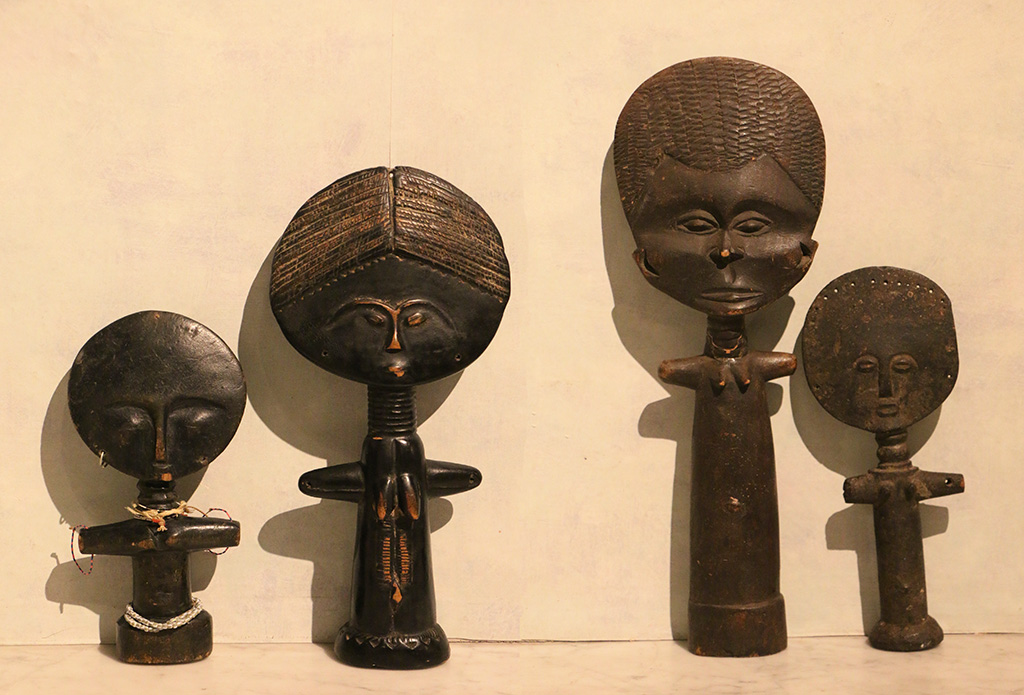The Asante region of southern Ghana is a remnant of the Asante empire, which was founded in the early 17th century when, according to legend, a Golden Stool descended from heaven into the lap of the first Asantehene (king), Osei Tutu. The stool is believed to house the spirit of the Asante people in the same way that an individual’s stool houses his spirit after death.
The most visible component of Asante art is royal regalia. The success of the Asante empire depended on the trade in gold not only with Europeans at the coast but also with the Muslim north. Gold therefore signified the basis of Asante authority; it covered the handles of state swords, diplomats’ staffs, containers for preciousitems, and jewelry, as well as the Golden Stool itself. Gold dust also served as Asante currency, and small cast-brass weights—at first geometric and later representational in style, and frequently signifying well-known proverbs—were used to measure it.
Asante weavers developed a style of great technical mastery, which incorporated imported cloth unraveled and rewoven into designs of enormous complexity; a dominant colour in these textiles, known today as kente cloth, is gold. Other arts well known among the Asante include a distinctive royal architecture, with facades deriving from the patterns of Islamic calligraphy; sculptures representing the Queen Mother; funerary vessels and terra-cotta “portrait” heads; and akuaba, wooden figures commissioned and cared for by women who desire a successful pregnancy.
TRIBES/TRIBUS/STÄMME
Asante
Asante weavers developed a style of great technical mastery, which incorporated imported cloth unraveled and rewoven into designs of enormous complexity; a dominant colour in these textiles, known today as kente cloth, is gold. Other arts well known among the Asante include a distinctive royal architecture, with facades deriving from the patterns of Islamic calligraphy; sculptures representing the Queen Mother; funerary vessels and terra-cotta “portrait” heads; and akuaba, wooden figures commissioned and cared for by women who desire a successful pregnancy.
QUATRES POUPEES ASHANTI
AKUABA, GHANA. BOIS, COLLIER
ET CEINTURE DE PERLES, PATINE
NOIRE D’USAGE ; ACQUIS DEBUT
1960, ÉPOQUE : DEBUT XXEME
SIECLE.

Akua’ba are wooden ritual fertility dolls from Southern Ghana and nearby areas.
Traditionally, these dolls are carried on the back of young women either hoping to conceive a child, or to ensure the attractiveness of the child being carried. When not in active use, the akua’ba would be ritually washed and cared for in the traditional homestead. The treatment of the Akua’ba has been described as an example of traditional beliefs that corresponds to many traditional believes in West African sympathetic magic.
The Fanti/Fante are part of the Akan group of ethnicities of Ghana and Ivory Coast, who all have matrilinear lineages. The majority of their sculpture reflects their concern with fertility and children, and they are known best for their fertility dolls and maternity figures.
These dolls are flat in shape by nature, so that women can carry them against them wrapped in their loincloth or tied up like a newborn baby carried on their back. In this way, they were used to stimulate fertility and to protect future newborns.
The name akua ba comes from the Akan legend of a woman named Akua who was barren, but like all Akan women, she desired most of all to bear children. She consulted a priest who instructed her to commission the carving of a small wooden child and to carry the surrogate child on her back as if it were real. Akua cared for the figure as she would a living baby, even giving it gifts of beads and other trinkets. She was laughed at and teased by fellow villagers, who began to call the wooden figure Akua ba, or “Akua’s child.” Eventually though, Akua conceived a child and gave birth to a beautiful baby girl. Soon thereafter, even her detractors began adopting the same practice to overcome barrenness.